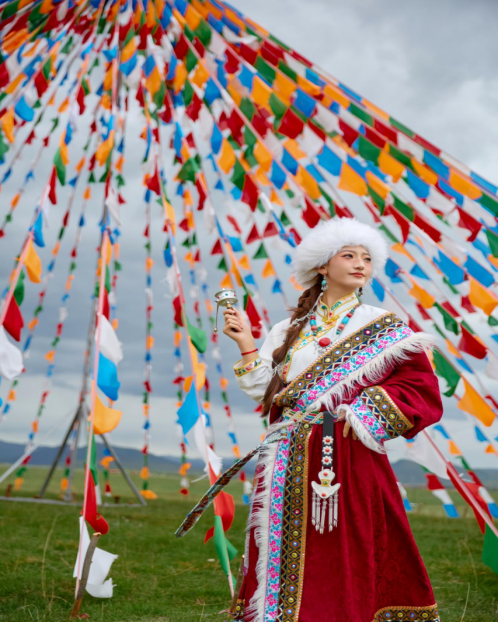It inherited the traditions of the Zhou and Han dynasties,it also paved the way for Emperor Zhu Yuanzhang of the Ming Dynasty,according to the traditions of the Han people,it absorbed the essence of Hanfu styles in the Tang and Song dynasties.it re-established the clothing system,this clothing system is Ming-style Hanfu,in the middle and late periods of its development.Ming-style Hanfu saw some styles unseen in previous dynasties, such as the stand-up collar.It also featured a large number of buttons in prominent positions on a garment.During the Qing Dynasty, it was gradually banned.However, a few styles and characteristics have been passed down to this day.

Hanfu of the Ming Dynasty VS Hanfu of the Tang Dynasty
Compared with Tang suits, the main feature of Hanfu in the Ming Dynasty lies in the obvious inversion of the proportion of the upper and lower garments. The upper garment was gradually lengthened, and the length of the exposed skirt was shortened, changing from short upper garment and long lower skirt. The collar also evolved from the collared collar of the Song Dynasty to mainly round collars. The upper garment of women’s clothing in the Ming Dynasty had three collars and narrow sleeves, with a length of more than three feet, and the exposed skirt was two or three inches, which is the so-called “flower crown, skirt and jacket, large sleeves and round collar”. There was also a special style of clothing in the Ming Dynasty, which was named “xiapei” because its shape was as beautiful as colorful clouds. Men’s clothing in the Ming Dynasty was mainly round-necked robes and Taoist robes.

The Performance of Hanfu of the Ming Dynasty in Modern Drama
Hanfu of the Ming Dynasty can be said to be the culmination of the ancient Chinese Hanfu system. In addition to seeing Hanfu of the Ming Dynasty in daily life or various other media, in fact, Hanfu of the Ming Dynasty also has its artistic shaping potential. For example, in modern dramas with ancient stories as the theme, we can also see Hanfu of the Ming Dynasty created for modern dramas.

The system of Hanfu in the Ming Dynasty was strict. When restoring Hanfu styles in modern dramas, it is necessary to take into account the selected style specifications, the identity of the characters, specific occasions and characteristics of the times. In modern dramas, the official uniforms of government officials are usually robes with coiled collars, right lapels and wide sleeves. There are corresponding hierarchical classifications in terms of color. For example, crimson is the color of official uniforms for officials of the first to fourth ranks, cyan for the fifth to seventh ranks, and green for the eighth to ninth ranks. The patterns on the robes correspond to different specifications and sizes of flower patterns or birds and beasts according to different ranks. Like in the modern drama The Fifth Year of Chongzhen in the Ming Dynasty, although the overall costumes are mainly Western-style clothes, the official crimson robes and embroidered patches in the prototype are still common styles of Hanfu for officials in the Ming Dynasty. In modern dramas, female characters usually wear short cross-collared jackets and matching mamianqun (horse-face skirts), which are common Hanfu styles for women in the Ming Dynasty. Younger characters will also add a “waist skirt” around their waists for the convenience of movement during performances, just like Du Liniang’s elegant jacket and skirt in the modern drama The Peony Pavilion. Such costume choices not only highlight the identity of the noble ladies from official families, but also perfectly set off the youth and beauty of the characters.

In modern dramas, we can also see a special kind of costume called “yesa” (a kind of traditional Chinese robe), which is a product integrating the clothing styles of the Yuan and Ming dynasties. It was originally a kind of riding and shooting clothing, and was changed to “wide sleeves and pipa-shaped hem” in the Ming Dynasty. The image costumes of military generals in the modern drama The Battle of Hulao Pass are like this.

In modern dramas, Hanfu of the Ming Dynasty mainly follows the principles of “better worn out than worn wrong”, “contextual transformation” and “group visual mobilization”. Even if the costume is old or worn out, it must not violate the basic shape requirements of the costume. It should be what it is, without additional changes. The costume must fit the character’s role. In order to strengthen the dramatic conflict in the play, appropriate element reconstruction can be done on the costume to set off the overall dramatic effect. When the leading role wears Hanfu of the Ming Dynasty or other styles, the colors and patterns will be more prominent, while the supporting roles will be visually weakened accordingly.
The appearance of Hanfu of the Ming Dynasty on the stage of modern dramas is a charming integration of tradition and modernity and a new interpretation of traditional culture. The soul of etiquette and the form of art show a different kind of cultural appeal in the presentation of modern dramas.







